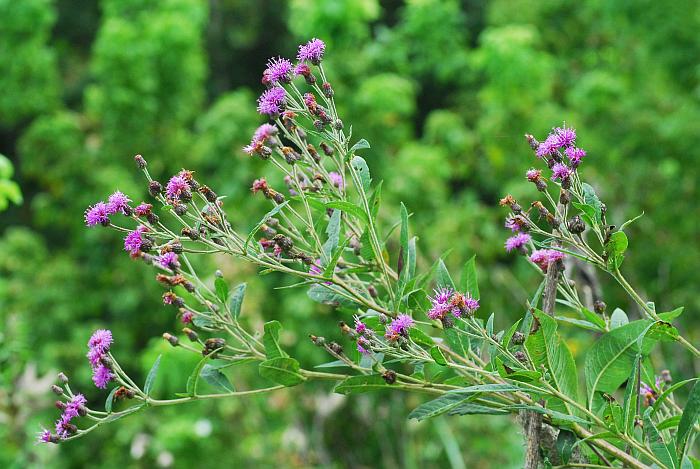Vernonia missurica Raf.
Missouri Ironweed

Native
CC = 5
CW = 0
MOC = 59
© SRTurner
Vernonia missurica Raf.Missouri Ironweed | |
 |
Native CC = 5 CW = 0 MOC = 59 |
© SRTurner |
|
Family - Asteraceae/Vernonieae Habit - Perennial forb with a stout, often short-rhizomatous rootstock. Stem - To 2 m, ascending to erect, on a stout rootstock, somewhat canescent and densely hairy with spreading or bent and tangled hairs, particularly toward the tips.
Leaves - Alternate, to 20 cm, lanceolate to ovate, coarsely toothed to nearly entire, upper surface usually minutely hairy, lower surface with evenly distributed, relatively long, often bent or tangled hairs.
Inflorescence - Irregularly branched terminal panicles, often somewhat flat-topped. Heads long-stalked.
Flowers - Involucre to 10 mm long, short-cylindrical to weakly hemispherical or bell-shaped, the bracts ovate to oblong-ovate, rounded or broadly angled to a bluntly pointed tip, stronly appressed, glabrous or minutely hairy, the margins usually cobwebby-hairy, usually uniformly dark purple. Florets 32-60 per head. Pappus tan to brownish purple, dimorphic, the inner bristles 6-8 mm long, the outer scales 0.6-1.0 mm long. Corollas 9-11 mm long, deeply lobed, purple.
Fruits - Achenes narrowly oblong, 6-8 mm long, not flattened, with 8- 10 relatively narrow ribs, usually hairy, at least along the ribs, grayish brown to brown.
Flowering - July - September. Habitat - Streambanks, bottomland forests, swamps, prairies, old fields, disturbed areas. Origin - Native to the U.S. Lookalikes - Other species of Vernonia. Other info. - This is one of several fairly common ironweeds found in Missouri. It is found most abundantly in the eastern half of the state, less commonly in the western regions. Beyond Missouri its range is predominantly within a wide band stretching from eastern Texas through Michigan. It can be distinguished from other ironweeds by its many (>30) florets per head, hairy leaf undersides, and strongly appressed involucral bracts. The last character is important for the identification of any Missouri ironweed, with the appressed bracts in this case serving as a counterpoint to the recurved bracts found in V. baldwinii. Vernonia missurica can be somewhat difficult to distinguish from V. gigantea, as both of these have appressed bracts. Photographs taken at Tyson County Park, St. Louis County, MO, 8-31-2018 and 9-4-2018 (SRTurner). |